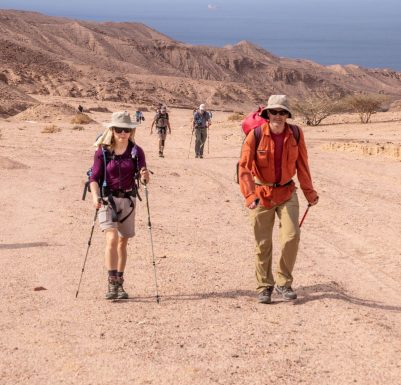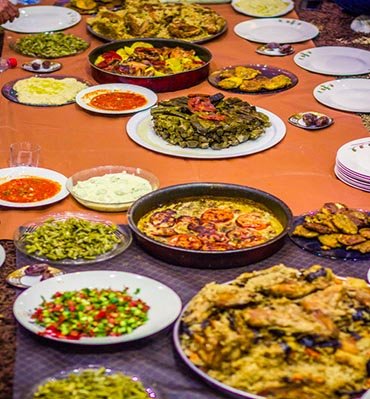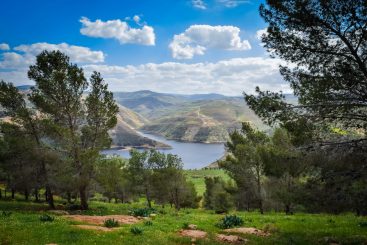What is the Jordan Trail?
The Jordan Trail is a long-distance hiking trail in Jordan connecting the length of Jordan from Um Qais in the north to Aqaba in the south. Offering 40 days of hiking over more than 675 kilometers of trail, and traveling through 75 villages and towns on its way. The trail traverses the diverse landscapes and vistas of the country, from the rolling wooded hills of the north, the rugged wadis, and cliffs overlooking the Jordan Rift Valley, the rose rock of Petra, the dramatic sands and towering mountains in Wadi Rum, to the crystal waters of the Red Sea.
As you walk the Jordan Trail, it becomes a journey through the history of Jordan and an encounter with its diverse culture. Traveling the length of the country enables a chance to peel through the different layers of culture, to taste the varied cuisines of Jordan, encounter locals while walking, and spending your nights in their home-stays. It is also an opportunity to learn the history of Jordan, the different civilizations who have made their marks on the land. The trail moves through major historical sites in the region such as Um Qais, Jerash, and Petra, while also harboring hidden ruins resting amongst the land.
This website contains many of your tools to start planning your hike on the Jordan Trail, including information about the route, tips to prepare for your journey, and a list of groups and companies leading walks on the trail. It is a trail that is still growing and developing therefore we invite participation in the development and maintenance of the trail, building a strong community around it and the Jordanian outdoors. If you have information about a part of the trail, photographs, or resources on travel logistics, share them!
How did the Jordan Trail come to be?
The concept of a trail crossing Jordan’s countryside is not a new one. For thousands of years, ancient paths and trade routes have cut across the land that today constitutes the state of Jordan. Jordan was the center of the King’s Highway, a trade route stretching from Egypt to Aqaba, and then north to Damascus. This route was used by Moabites, Edomites, and Ammonites, but during the first centuries B.C. the Nabatean merchants extended this route further to Asia and southern Arabia making Jordan a center of their empire, with Petra the crown jewel amongst this. After the Nabatean reign, the Roman Empire continued to utilize these routes as critical pieces of its Middle Eastern network of roads.
Traveling Jordan by foot is a practice that is as old as these ancient trails. For thousands of years, it served as a means of conducting business and communicating with distant peoples. That same action of walking is still bringing people through Jordan’s countryside; now it is hikers who traverse the terrain with the purpose of recreation and experiencing the country’s beautiful natural landscapes and diverse communities. In recent years, the fields of outdoor recreation and adventure travel have grown rapidly in Jordan; and many groups have sprung up to bring both Jordanians and tourists into closer interaction with the country’s beautiful natural offerings.
The concept for the Jordan Trail originated in the midst of this explosion of outdoor exploration in Jordan and was developed by several people and organizations that were integrally involved in the country’s growing outdoor scene. Those working to scout new trails and to create one continuous Jordan Trail are being greatly assisted by other groups and by local enthusiasts from each of the trail’s regions. Many Bedouin tribes are helping to develop the trail sections between Petra, Wadi Rum, and Aqaba, while the northern sections and around Karak have received endless support and help from local hikers and groups. From north to south, the entire length of the trail is supported and made possible by the tireless efforts of people and organizations who are dedicated to the project.


In July 2015, the Jordan Trail Association was formed to take on the responsibility of the development of the trail and its maintenance, in addition to facilitating its accessibility by establishing strong connections for all concerned and providing comprehensive information regarding the trail. As of mid-2016, the JTA received a grant from USAID, support from the Jordan Tourism Board, and contributions from the private sector, besides, to support by many local volunteers that aid the JTA in achieving its goals. The Jordan Trail facilitates the economic development of local communities through job creation, and the country’s economy to create minimum impact tourism which promotes an outdoor culture and environmental awareness. So far, the JTA has increased capacity building of the association, waymarked sections of the Jordan Trail from Um Qais to Ajloun, re-scouted and made improvements on the trail, built relationships with service providers along the trail (including homestays and guide training), and advertised and marketed the trail globally and locally.










